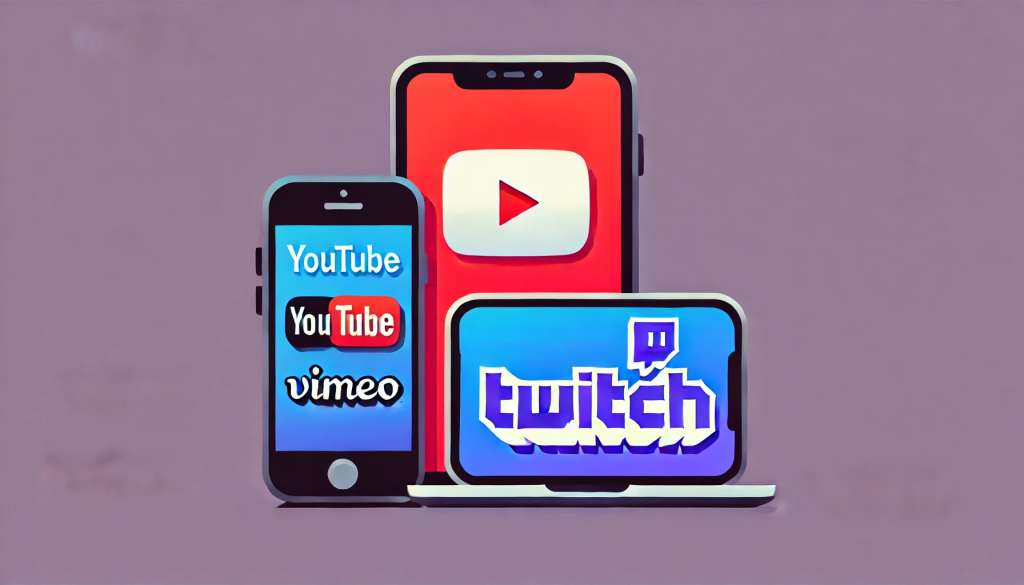
In today’s digital age, video content and live streaming have become essential tools for bloggers to engage with their audience and generate income. With numerous platforms available, choosing the right one can significantly impact a blogger’s ability to monetize their content effectively. In this article, we’ll compare four major platforms: YouTube, Vimeo, Twitch, and Sprintty, to help bloggers make informed decisions based on their content strategy, target audience, and monetization goals.
YouTube
Pros:
Diverse Monetization Options:
- Ad Revenue: YouTube’s Partner Program (YPP) allows creators to earn through ads displayed on their videos.
- Channel Memberships and Super Chat: Viewers can support creators through memberships and live chat donations.
- Merchandise Shelf: Creators can sell merchandise directly to their audience.
- YouTube Premium: Additional revenue from premium subscribers who watch their content.
- Super Thanks: Enables viewers to tip creators on uploaded videos.
Massive Audience Reach:
- Over 2 Billion Users: With over 2 billion monthly logged-in users, YouTube offers a vast potential audience.
- Strong Discoverability: Advanced algorithms help videos reach a broader audience through recommendations and search features.
Community Engagement:
- Robust features for community interaction through comments, live chats, and community posts.
Cons:
Revenue Split:
- Ad Revenue Share: YouTube takes a 45% cut of ad revenue.
Content Control:
- Strict Policies: Strict community guidelines and copyright policies can lead to demonetization or video removal.
High Competition:
- Crowded Platform: Standing out can be challenging due to the large number of creators.
Vimeo
Pros:
Flexible Monetization Options:
- Vimeo On Demand: Allows creators to sell their videos directly to viewers or set up a subscription service.
- Vimeo OTT: For building a subscription-based video service.
- Tip Jar and Pay-per-view: Additional monetization options.
Content Control:
- Less Strict Policies: More relaxed content guidelines compared to YouTube.
- Customization: Greater control over video presentation, including ad-free viewing and customizable video players.
Quality and Niche Audience:
- Higher Video Quality: Known for better video quality and playback options.
- Niche Community: Attracts a creative, professional, and niche audience.
Cons:
Smaller Audience Reach:
- Limited User Base: Vimeo has a significantly smaller audience compared to YouTube.
Cost:
- Subscription Fees: Accessing advanced features and monetization options requires paying for Vimeo’s premium plans.
Limited Discoverability:
- Fewer Algorithms: Lacks the extensive discovery and recommendation algorithms of YouTube.
Twitch
Pros:
Monetization for Live Streaming:
- Ad Revenue: Through Twitch Affiliate and Partner programs.
- Subscriptions: Viewers can subscribe to channels through Twitch Prime.
- Bits: Viewers can purchase and use Bits to cheer for streamers.
- Sponsorships and Donations: Additional income through direct viewer support.
Interactive Community:
- Live Interaction: Strong community engagement through live chats, emotes, and interactive features.
- Active User Base: Millions of daily users with a focus on live streaming content.
High-Quality Streaming:
- Superior Live Streaming Quality: Known for its high-quality streaming capabilities.
Cons:
High Competition:
- Competitive Environment: Particularly challenging in popular categories like gaming and entertainment.
Strict Content Policies:
- DMCA Enforcement: Strict guidelines and copyright policies.
Revenue Split:
- Subscription Revenue Share: Typically a 50% cut, though negotiable for top partners.
Sprintty
Pros:
Effortless Setup:
- Quick and Easy: Sprintty enables users to build their own video streaming services quickly and effortlessly.
Monetization Flexibility:
- Multiple Revenue Streams: Offers options like subscriptions, pay-per-view, and ad integrations.
- Full Revenue Control: Creators keep a higher percentage of their earnings compared to other platforms.
Customization and Branding:
- Tailored Experience: Complete control over branding and user experience, making it ideal for bloggers looking to create a unique platform.
Scalability:
- Growth Ready: Scalable solutions that grow with the creator’s audience and content library.
Cons:
Initial Investment:
- Setup Costs: Requires an initial investment for setting up the platform.
Audience Building:
- Self-Promotion Needed: Creators need to actively promote their platform to build an audience, as Sprintty does not provide a built-in user base.
Conclusion
YouTube: Ideal for bloggers aiming to reach a large audience and utilize multiple monetization methods. It’s perfect for those who can navigate its competitive environment and strict content policies.
Vimeo: Best suited for bloggers who prioritize content control, higher video quality, and targeting a niche audience. While it requires investment in premium plans, it offers greater flexibility and more relaxed content guidelines.
Twitch: Tailored for bloggers focusing on live streaming, particularly in gaming and entertainment. It provides several interactive community features and monetization options, though it also has high competition and strict content policies.
Sprintty: Excellent for bloggers who want complete control over their video streaming service, offering flexible monetization and customization options. It’s ideal for those willing to invest in creating a unique platform and actively promoting it to build an audience.
Ultimately, the choice depends on the blogger’s content strategy, target audience, and willingness to invest in premium features for greater control and quality. By carefully considering these factors, bloggers can select the platform that best aligns with their goals and maximizes their earning potential.
Want to know more about how Sprintty.com can help you to launch your own streaming service and increase revenue from your video and Live streams? Contact us: hello@sprintty.com
